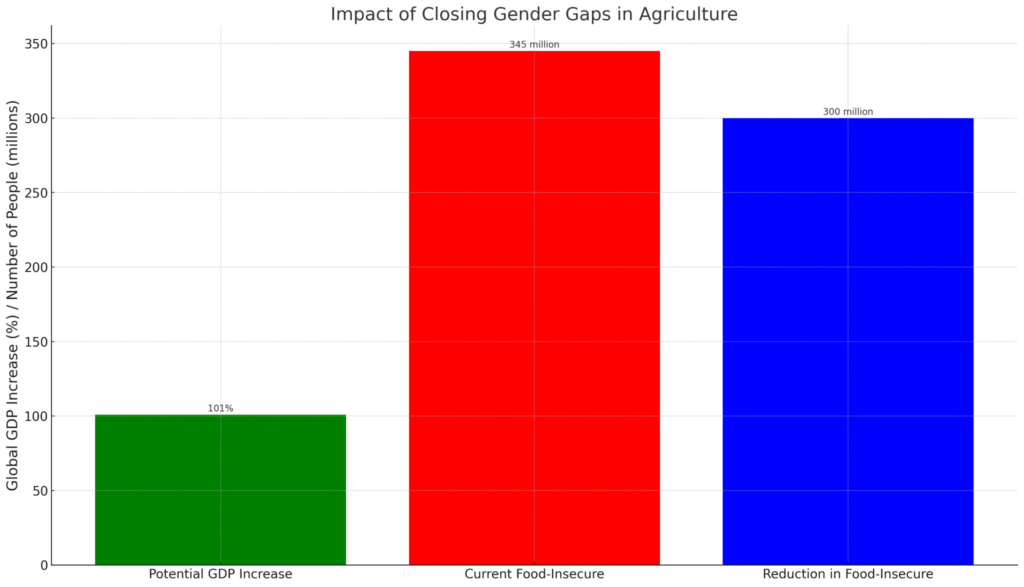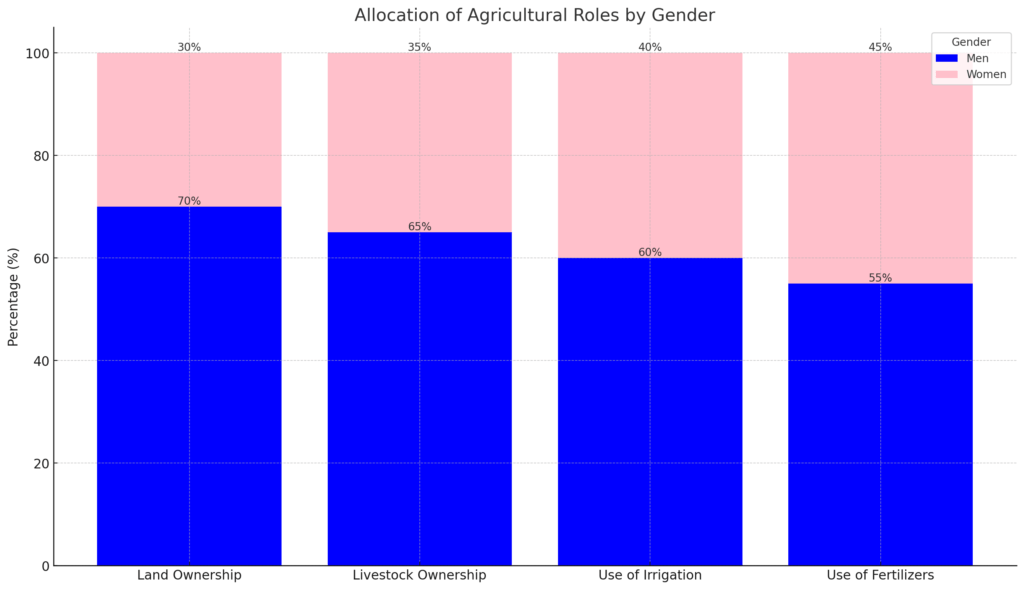
Delve into the economic impact of gender disparities in the agrifood industry.
By Darius Spearman (africanelements.org.)
Support African Elements at patreon.com/africanelements and hear recent news in a single playlist. Additionally, you can gain early access to ad-free video content.
Table of Key Takeaways:
| Key Takeaways |
|---|
| Gender inequality in African agrifood systems costs the global economy nearly $1 trillion. |
| Closing gender gaps in agriculture can boost GDP, enhance food security, and reduce poverty. |
| Women face significant barriers in agriculture, including unequal access to resources and education. |
| Policies ensuring equal access to land, credit, and technology are crucial for economic growth. |
| Empowering women in agriculture leads to higher productivity and economic stability. |
| Educational programs and robust social protections enhance women’s roles in agrifood systems. |
| Collaboration across all levels is necessary to implement and support measures fostering gender equality. |
Introduction to Gender Gaps in African Agrifood Economics
In African agrifood systems, gender inequality presents a significant economic challenge. Notably, this disparity costs the global economy nearly $1 trillion due to productivity and wage gaps. Therefore, addressing these inequalities could propel economic growth across the continent and enhance global food security. Indeed, fostering gender parity is not just a moral imperative but a financial one too. According to the Food and Agriculture Organization of the United Nations (FAO):
“Women have always worked in agrifood systems. It is time that we made agrifood systems work for women.” – FAO Director-General Qu Dongyu. (UN News)
Thus, this article aims to unpack the economic repercussions of gender gaps in agriculture. Moreover, it will explore strategic solutions to bridge these gaps. As we delve into this discussion, we recognize the potential of gender equity to transform African economies fundamentally.
Exploring the Gender Productivity Gap in African Agrifood Systems
Gender Disparities and Economic Impact in Agriculture
In African agrifood systems, gender-based barriers significantly hinder women’s economic potential. These barriers, primarily due to unequal access to resources and education, create a productivity gap between women and men on equally sized farms. This inequality not only restricts women’s economic contributions but also hampers broader economic growth across the continent.
“But in a new report, FAO says that gender inequalities such as less access for women to knowledge and resources, and a higher unpaid care burden, account for a 24 per cent gap in productivity between women and men farmers on farms of equal size.” (UN News)
Food Safety Standards and Gender Equality in Agrifood
Moreover, the challenges extend beyond productivity, encompassing food safety concerns. Small and medium-sized enterprises, pivotal in African agrifood sectors, often struggle to meet international food safety standards. This difficulty highlights another layer of complexity in the gender equality battle within the agrifood sector and underscores the critical need for robust support systems to empower women comprehensively.
“But small and medium-sized companies in Africa struggle to meet international food safety standards, which often go above what is required on a national level.” (IPS News)
Thus, addressing these multifaceted challenges requires a holistic approach. Furthermore, it necessitates collaboration between governments, private sectors, and non-governmental organizations. By tackling these issues, we pave the way for a more equitable and prosperous African agrifood system.
Boosting Economic Growth by Closing Gender Gaps in Agriculture
Potential Economic Gains from Gender Parity

Addressing gender disparities in agriculture not only promotes fairness but also catalyzes significant economic growth. For instance, closing the productivity and wage gaps can surge global GDP. Moreover, this economic boost would enhance global food security and reduce poverty.
“Closing the gender gap in farm productivity and the wage gap in agricultural employment would increase global gross domestic product by nearly $1 trillion.” (UN News)
Additionally, bridging these gaps ensures more sustainable development outcomes. Thus, achieving gender parity in agriculture is not only equitable but also economically prudent.
Ripple Effects on Global Food Security
Furthermore, improving gender equality in agrifood systems significantly reduces the number of food-insecure people. Indeed, better resource access for women can decrease global food insecurity by 45 million people. Therefore, empowering women in agriculture extends beyond individual benefits to global advancements.
“If we tackle the gender inequalities endemic in agrifood systems and empower women, the world will take a leap forward in addressing the goals of ending poverty and creating a world free from hunger.” – FAO Director-General Qu Dongyu. (UN News)
Hence, the efforts to close gender gaps not only transform the agrifood sector but also bolster resilience against global food crises.
Encouraging Development and Policy Support
Supporting policies and interventions that foster gender equality is crucial. Similarly, investing in women’s agricultural education and resource access propels economic and social development. Thus, these initiatives are essential for creating a fair and thriving agrifood sector.
Strategic Interventions for Achieving Gender Parity in Agrifood Systems
Implementing Policies for Equitable Resource Access

To eliminate gender disparities, introducing and enforcing equitable policies is crucial. Notably, these policies should ensure that women have equal access to land, credit, and technology. As a result, such measures can greatly enhance their productivity and economic stability.
“In many countries, there still is much to do to ensure that women own land in equal proportion to men and that legal frameworks protect their rights.” (UN News)
Moreover, strengthening these policies supports sustainable development, promoting long-term economic growth across the continent.
Educating and Empowering Women in Agrifood
Furthermore, education and training for women in agrifood sectors are pivotal. These initiatives not only improve their skills but also boost their productivity significantly. Consequently, empowered women can drive innovation and growth within the sector.
Additionally, targeted educational programs can break the cycle of poverty and increase women’s agency, contributing to more resilient agrifood systems.
Enhancing Social Protection and Support Systems
Lastly, enhancing social protection can safeguard women from economic shocks, especially during crises like the COVID-19 pandemic. By doing so, social protection programs can stabilize incomes and ensure continuous productivity.
“Social protection programmes have shown to increase women’s employment and resilience.” (UN News)
Therefore, robust social protection is essential not only for supporting women during downturns but also for maintaining the stability of the agrifood systems in which they operate.
Catalyzing Growth by Empowering Women in Agrifood
In summary, addressing gender inequality in African agrifood systems presents a formidable opportunity for economic and social advancement. Importantly, closing gender gaps not only enhances women’s lives but also boosts the entire continent’s economic stability and food security.
Moreover, the integration of gender parity into agrifood policies and practices is essential for sustainable development. Consequently, these actions pave the way for a more equitable and prosperous future for all.
Thus, it is imperative that stakeholders across all levels — from local communities to global leaders — commit to implementing and supporting measures that foster gender equality. Therefore, let us champion these changes, not just for the sake of fairness but for the enduring benefits they bring to our global community.
FAQ Section:
Q: Why is gender inequality in agriculture a significant issue?
A: Gender inequality restricts economic growth and food security, costing the global economy significantly.
Q: What are the economic benefits of closing gender gaps in agriculture?
A: Closing these gaps can increase global GDP by nearly $1 trillion and significantly reduce the number of food-insecure people.
Q: What barriers do women face in African agrifood systems?
A: Women often have less access to necessary resources like land, credit, and technology, alongside facing higher burdens of unpaid care work.
Q: How can empowering women in agriculture benefit the economy?
A: Empowering women leads to higher productivity, better crop yields, and overall economic stability in agrifood systems.
Q: What actions are recommended to address gender inequality in agriculture?
A: Implementing equitable policies, enhancing education and training for women, and improving social protections are key strategies.
About the Author
Darius Spearman, a professor of Black Studies at San Diego City College, has been a passionate educator and advocate for social justice since 2007. He is the author of several influential books, including Between The Color Lines: A History of African Americans on the California Frontier Through 1890. Spearman’s commitment to education and empowerment extends beyond the classroom, impacting communities through insightful analysis and impactful storytelling. Visit Darius online at africanelements.org.
